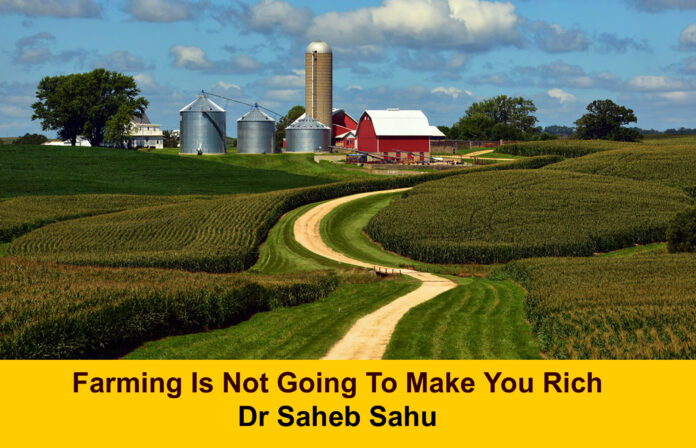Dr Saheb Sahu
$1(US) = 87 Indian Rupees
1 Bushel= 14.5 Kg
1 Acre= 0.40 hectare
Introduction
The Midwest in America, often referred to as America’s “bread basket”, has been central to America’s agricultural output. It is a vast fertile plains consisting of 12 out of 50 states. The states are: Illinois, Indiana, Iowa, Kansas, Michigan, Minnesota, Missouri, Nebraska, North Dakota, South Dakota, and Wisconsin. These states mostly produce corn, wheat, soybean, and few other crops. They also raise livestock like: cattle, dairy cows, hog (pig), chicken, and turkey.
According to the US Department of Agriculture (USDA), 3.4 million people work in farms in the United States. That is about 1% of the population of 340 million.
After graduating from AIIMS (New Delhi), I moved to Des Moines, Iowa in 1970. After finishing my pediatric training, I went into private practice, did well, and stayed. I have been in the state of Iowa for more than 54 years. I know the economy of the state reasonably well. My parents were farmers in Odisha, India. I have reasonably good knowledge about life struggle of an Oriya farm family. In this article I will compare the economic state of an Iowa farmer family with that of a farmer family in Odisha.
Iowa is considered one of the most fertile states among the Midwestern states. The land mass of Iowa is about 56,000 square miles. 85% of its land is used for farming. Iowa’s population is 3.4 million out of which 158,000 are farmers, both men and women. That is 4.6% of the population. The average size of an Iowa farm is 345 acres. Iowa farmers raise about 3.4 million cattle and calves, 25 million hogs (pigs), 225,000 sheep and goats, and 54 million poultry. In 2023, Iowa farmers harvested 2.5 billion bushels of corn and 570 million bushels of soybean. They export their farm products to all over the world, especially to China. In 2022, the total farm receipt was approximately 29 billion dollars.
Recent data indicate a troubling trend in the number of farms in the Midwest. Between 2017 and 2022, 30,000 farms ceased operation. Consolidation has led to a large farms becoming more dominant, squeezing out mid-sized operations and making it increasingly difficult for new farmers to enter the industry. Yes, in America farms operate like small scale industries. Iowa famers need big machineries and lots of capital to stay in business. They take big loan to finance their purchases and when farm income is down (during the farm crises), they cannot afford to pay those loans and lose their farms. It happens every few years. For example, despite record harvest, in 2024, the average Iowa farm faced projected loss of $30, 00.0, making it the lowest farm income year since 1980.
In 2018, the average Iowa farm household income was $126,000.0, well above national average. But, 40% of this income came from non-farm related activities like one spouse working outside the farm, selling seeds and fertilizers. In 2023, the farm household income dropped to $65,000.0. By contrast, the nonfarm household income in Iowa was $96,000.0. Thus farming is a risky business.
Many American farm families hold great wealth in the form of land that is increasingly becoming more valuable. Foreigners like Saudis and Chinese are buying American farm lands. However, like farmers everywhere in the world, American farmers are having harder time to make a living on it.They are land rich, cash poor.
India and Odisha Context
My parents were farmers in the state of Odisha from 1940s to 1970s. They farmed about 5 acres of non-irrigated land. They grew paddy, sugar cane, jute, potatoes, onions and some vegetables. As a child I have helped my dad in irrigating the vegetable field. Even though our family has left the village since 1970, we still, own the land. Today, my first cousin (uncle’s son) farms our ancestral land. No other Sahu is into farming now. They are all well-educated and working in urban areas. I visit my birth village every 3-4 years and keep in touch with my old classmates and their children who are farmers.
According to 2015-16 Agriculture Census, the average size of a farm in India was 1.08 hectares (2.66acres) a decrease of 1.41 hectares from 195-96. The average monthly income (according to NABARD) of an Indian farmer household in 2021-22 was 13,660.0.rupees compared to 11,450 rupees for a non-farm household.
Odisha
The state of Odisha covers approximately 60,000 square miles. 40% of it is farming land. Odisha’s population is about 46 million. 76% of Odisha’s population is engaged in agriculture. In Odisha, the average income for a farm house-hold was 5,112rupees (National Bank for Agriculture and Rural Development survey 2021-22), compared to 26,700 rupees in Punjab. Odisha’s farmers had the second lowest income among all the Indian states. Agriculture in Odisha is characterized by low productivity, inadequate irrigation facilities, small size of the land holding and low capital investment. 62% of the cultivable land is rain fed and exposed to the vagaries of monsoon. Farmers face draught, flood, pest, inadequate storage facilities, low crop price and many other hurdles. It is not easy to make living as a farmer in Odisha. Large numbers of them are migrating to southern states to work as laborers.
My Personal Take on Farming
I have been in the State of Iowa for 54 years and going. My elder son’s college roommate is a farmer in Iowa. He farms about 1600 acres of fertile land that needs no irrigation. He rents the farm from his father and uncle. His wife, a college graduate, works full time as an assistant museum director in a nearby city. His brother is an engineer who works outside Iowa. I see my son’s friend at least once a year and we talk about farming. Besides farming, he also sells seeds. He and his wife live a middle class American life but by no means they will be considered rich. The average net worth (USDA’s 2022) of an American farmer is $3.2 million. It is more than most Americans. But farmers are land rich and cash poor. They will get that amount of money if only they sell their land. Most farmers don’t want to sell their land to an outside buyer. They want to pass it on to the next generation. But most of the next generations of Americans don’t want to be farmers. After getting an education, they are moving into urban areas for higher income and better quality of life.
As a general rule farmers in India are not in good shape. The farmers in Odisha are in much worse shape than their counterparts in other states. Their monthly income is one of the lowest among the states. They are earning less than unskilled laborers. They are at the mercy of the weather, pest, bankers, insurance agents and the politicians. They live in rural areas with poor infrastructures, education and health care. Their life-span is shorter.
Based on my personal observations of farming life in India and America, I will advise young people in Odisha, not to aspire to be a farmer. Get the maximum education you can get, especially in STEM (Science, Technology, Engineering, and Math) fields. Move to a nearby town or city or even overseas for better career opportunities. For a short time you will miss your village life but in the long run, you will be richer, healthier and live a better life. Your children may even do better than you did.
Sources:
1-Brian Reisinger. Land Rich, Cash Poor. Skyhorse Publishing: New York, 2024
2-USDepartment of Agriculture. www. usda.gov
3- Odisha economic Survey 2023-24. PC.Odisha.gov.in
4- Chat-Gpt. 2-2-25
5- Wikipedia. Wikipedia.org. 2-2-25



